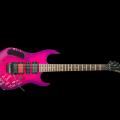tuneyoursound.com is proud to team up with the Groninger Museum for this exceptional exhibition on 'The Myth of the Electric Guitar', 14 January 2015 to 9 March 2015.
More details can be found here: EXHIBITION at GRONINGER MUSEUM : The Myth of the Electric Guitar
The electric guitar is the result of many inventors and musicians working to develop, design, and popularise a louder instrument. The desire to increase the volume of the sound of the guitar emerged in the 19th century due to the evolution of the music. Initially this was tried to be achieved by using new materials and designs. The introduction of the steel strings and the arch-top design in the 19th century made this possible but proved not sufficient to amplify the sound. New ways were searched by developing alternative designs, such as the dreadnaught type of acoustic guitar, the harp guitar and the resonator guitar. Especially the resonator guitar, which is still popular today in certain music genres, was a complex technical innovation to make guitars louder. Introduced in the late ’20 the resonator guitar features aluminium speaker-shaped cones built into the top of the guitar and which create sound by the vibrations of the resonator cones, not of the body itself.
With the advent of the big band music in the ’20, phonograph recordings, commercial radio and the spreading commercialisation of electrical devices the time was right for experimenting with different materials and concepts. In the early ’30 George Beauchamp, working with Swiss immigrant Adolph Rickenbacher (later Rickenbacker), developed an electromagnetic pickup to amplify the sound of the guitar. This was made possible due to the use of steel strings. The vibrations of the steel strings were creating electrical fields in the pickup which is basically a coil of wire wrapped around a magnet in which a current passes through. This electrical signal created by the vibration of the steel strings is then amplified by an external guitar amplifier driving a speaker. The result of those experimentations was the first commercial viable electric guitar produced from 1932 on: the lap-steel guitar known as Frying Pan.
Technically developed as wood guitar, the production model was made of a hollow aluminium body. This generated some unwanted resonances and a lot of musicians put newspaper inside to get rid of those interferences. In 1935 a new model was introduced by Rickenbacher: the Electro Spanish (Model B) lap-steel guitar. This is considered to be the precursor to solid-body Spanish-style electric guitars. Made of Bakelite, the first synthetic plastic, it has cavities in the body which are there to reduce the weight and which are concealed by stainless-steel cavity covers.Featured also is a detachable neck and a horseshoe pickup as on the Frying Pan model.
A more traditional approach was followed by Gibson around 1936, with its ES-150 electric-acoustic guitar. This guitar, which is based on a classic acoustic arch-top guitar, was the first Spanish-style electric guitar to achieve commercial significance, thanks in part to Charlie Christian, Spanish-style electric guitar to achieve commercial significance, thanks in part to Charlie Christian, a jazz guitar player who brought it to the forefront as a lead instrument.
Compared to the Rickenbacher’s horseshoe pickup configuration with magnets directly surrounding the strings, the pickup coil and the two magnets of the ES-150 are placed below the strings. This pickup design was nicknamed the "Christian" in honour of Charlie Christian, who made this guitar popular. It was also this or similar designs which were retained by most of electric guitars builders to come.
By the mid ’30 the major two schools how to build electric guitars were established:
On one hand the traditional Spanish-style acoustic guitar amplified by pickups placed on the top of guitar body. This was for long years the privileged domain of Gibson until they developed also a solid body guitar: the Les Paul which became a classic.
On the other hand, derived from the lap-steel guitar, the solid body Spanish-style electric guitar emerged as first mass-produced electric guitar. The approach chosen by Leo Fender to build a simple solid-body electric guitar with a screwed-on neck proved the right one to mass-produce and make the electric guitar popular. His first guitar produced in the mid ’40 was still a lap-steel guitar under the brand K&F. With "Doc" Kauffman, who had worked for Rickenbacher's Electro String Instrument Corporation, Leo Fender developed a lap-steel guitar around a direct string pickup. By 1950, after Kaufmann had left, he quickly moved on under the Fender brand to develop the two most distinctive solid-body electric guitars of all times: the Telecaster and the Stratocaster.
To illustrate the evolution of the electric guitar a selection of instruments have been chosen for display. There are many others, but these are considered as being iconic and widely recognised as being the first mass produced electric guitars.
There are 4 categories:
- The historic instruments
In the industrial design of the electric guitar major factors are look and efficiency of the shape as well as the acoustical aspects. Over the time many designs have been tried out to improve playability and the sonic possibilities of the electric guitar, including digitalisation. The results were odd shapes as well as very practical and convenient solutions to improve the usability of the guitar.
Nevertheless after more than 80 years of experimentation, three major designs stand out:
- The Fender Telecaster
- The Fender Stratocaster
- The Gibson Les Paul.
Those three classics designs are still today the most popular and inspire luthiers all over the world to build guitars on those standard platforms. Even if innovation and qualitative improvements are constant drivers, it remains that the overall technical concept and the global design stay more or less the same since their original creation.
Enjoy to discover those guitars in the exhibition. A virtual visit is proposed on the following page: EXHIBITION at GRONINGER MUSEUM : The Myth of the Electric Guitar











